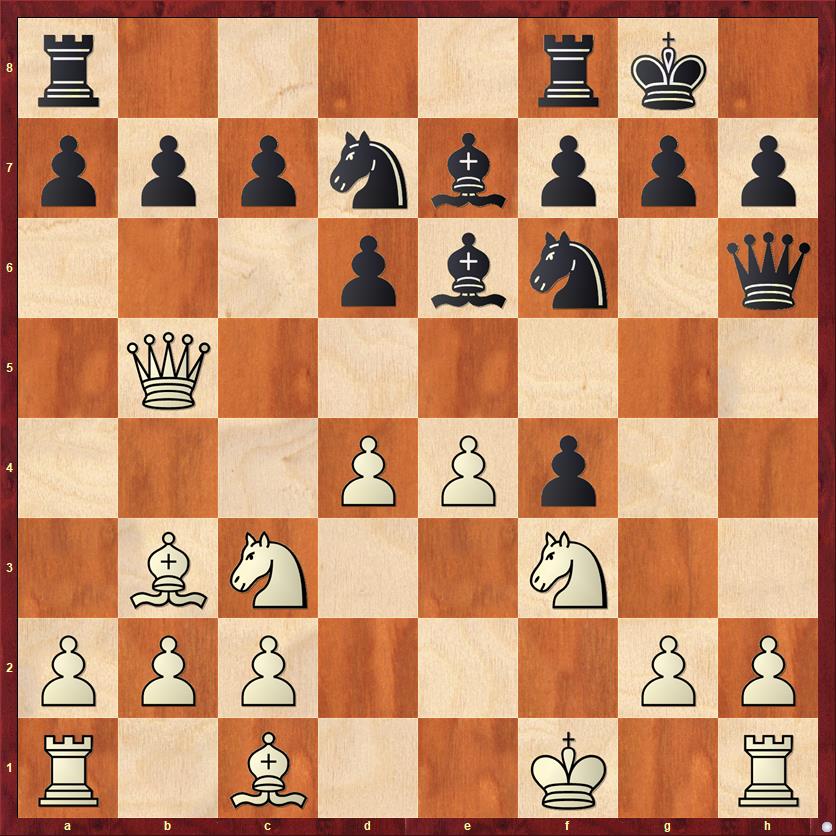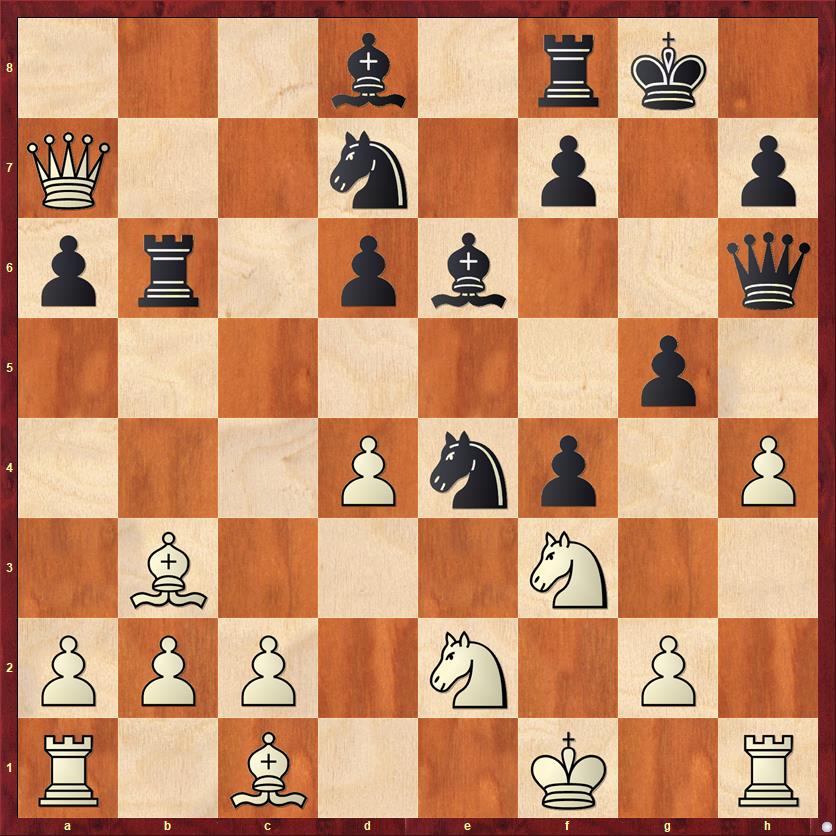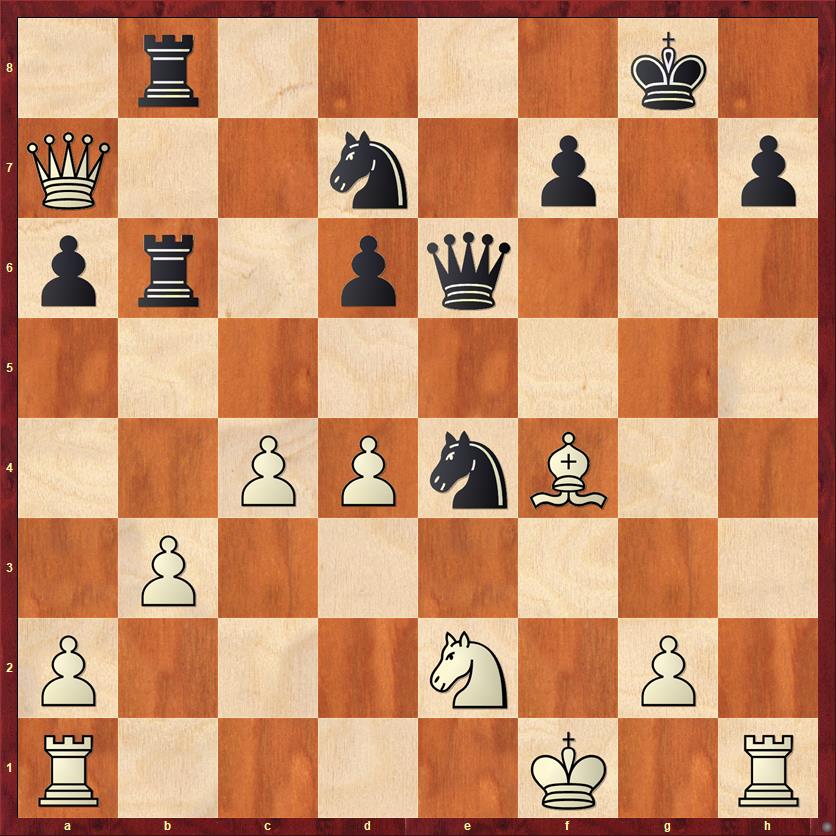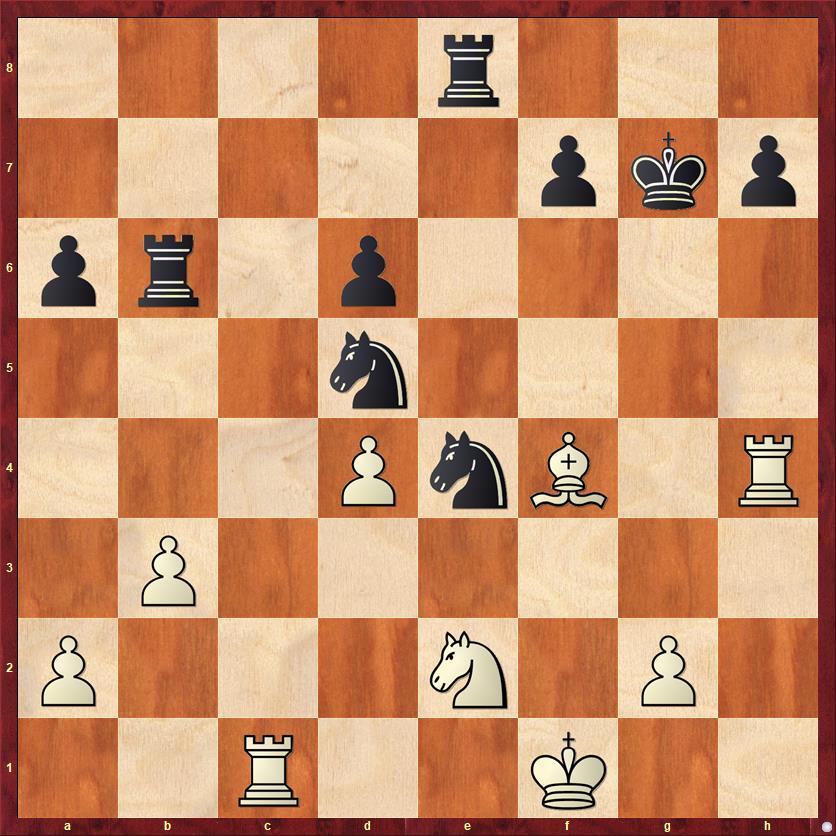Last month I received a surprise e-mail from Mackenzie Molner, a grandmaster who is launching a “chess academy” at grandmastermac.com. He asked if I would be interested in having him write a guest post for my blog, as a way of cross-promoting both my blog and his website.
I had never spoken with Mac before, but of course I knew his name. It’s not the sort of name I would forget, because it’s the same as mine! I told him that I’ve never had a guest post on my blog, because I have always wanted it to have my “brand,” but on the other hand I was very interested in the whole cross-promotion idea. So I asked him if he would be interested in playing two games with me at chess.com, and then writing down his commentary. Actually, my idea was that we could both analyze the games, so that readers of the blog could see what we were both thinking. Mac liked that idea, so we played our first game on May 9.
It was a very exciting game, complicated in both tactics and strategy, and with mistakes on both sides. We played at a time control of 30 minutes for the game with a 5-second time increment per move. As you’ll see, time was a very critical factor. As promised, I’ll show you the moves with annotation by both players. My annotations are identified with (DM) and his are identified with (MM).
NM Dana Mackenzie — GM Mackenzie Molner
1. e4 e5 2. f4 …
The move I was least prepared for. With that said, the King’s Gambit always leads to exciting and fun games, so it wasn’t a terrible surprise to face it. (MM) Readers of this blog know that the King’s Gambit is one of my regular openings, for exactly the same reasons. (DM)
2. … ef 3. Bc4 …
I couldn’t remember much analysis after 3. Bc4, so I just tried to go with a recommendation I saw in the Quality Chess book, 1. … e5 Repertoire by Ntirlis. (MM)
3. … Qh4+
I think this move has a bit of questionable reputation because it is going to allow White to develop with tempo after a future Nf3, but Ilike compromising White’s king. I also like the idea of dropping the queen back to h6 to hold on to the f4 pawn. (MM) We’ll see that the “compromised king” plays a huge role in this game. Nevertheless, playing against a Grandmaster, I was extremely happy to see Mac’s third move. It promises a sharp, tactical game where the Grandmaster will not be able to squeeze me to death; he’ll have to engage in a bare-knuckle brawl. The most commonly played alternative is 3. … Nf6, when Black usually does not attempt to hold the extra pawn but instead concentrates on developing his pieces naturally. (DM)
4. Kf1 Nf6 5. Nf3 …
It’s important to play this move right away! On 5. Nc3 or 5. d4 Black plays 5. … Ng4 and White loses his chance to chase the queen away with Nf3. (DM)
5. … Qh6 6. Nc3 …
One of my students asked me a great question: Why not win a pawn with 6. Ne5? The answer is very instructive: Black defends and attacks simultaneously with 6. … d5! A very common theme in double e-pawn openings: Black temporarily sacrifices a pawn for the sake of rapid development. (DM)
6. … d6 7. d4 …
At this point I felt a little fuzzy about what to do with Black. I vaguely remembered a combination of different plans that Black can try at some point. … g7-g5 was a major plan that I was looking to implement, to helkp bother the knight at f3 and start a kingside initiative. I also thought that … Be6 as well as … Bg4 were moves to consider. Even just playing naturally with something like … Be7 and … c6 looks reasonable as well. (MM) Mac’s comment is very instructive for class-level players. Note that he thinks in terms of plans, not moves. And he doesn’t consider just one plan. The only thing I wonder is, how did he choose from among the four plans he mentioned? (DM)
7. … Be6 8. Bb3 …
I had been in this exact position before, twice in fact, both at the 2019 Bay Area International. (I won one and lost one.) I decided to use the same plan (Bb3, Qd3, Qb5) that I had used before. Against a GM, it’s better to play openings and positions you’re familiar with, instead of improvising over the board. However, next time I might try something different. (DM)
8. … Be7 9. Qd3 …
Clearly, White would like to play Qb5+ if allowed to do so. I considered playing … Nbd7, … c6, or just … O-O. I eventually decided on Nbd7 because it seemed the most flexible. It prevents White’s double attack and doesn’t commit the Black king to castling kingside yet. I wanted to hold off on that in order to better enable the … g7-g5 plan that I mentioned earlier. After … Nbd7 there is also a chance that Black can castle queenside. (MM) Again an instructive comment for class-level players! Notice that Mac places a high value on flexibility, on moves that don’t commit you to one plan and don’t give away too much information to the opponent. In my experience, amateurs think less about flexibility than masters do. (DM)
9. … Nbd7 10. Qb5 O-O
It never even crossed my mind to defend the b-pawn here. However, the thing I found most annoying about White’s last move was that it defends the square g5 an extra time. This makes it harder to accomplish my main plan, which is frustrating. I decided to castle here because I felt that if White captures on b7 it is a lot of time invested into regaining material, and in the meantime I can advance on the kingside. (MM)

FEN: r4rk1/pppnbppp/3pbn1q/1Q6/3PPp2/1BN2N2/PPP3PP/R1B2K1R w – – 0 11
The next move is perhaps the most important turning point in the game. (DM)
11. Ne2!? …
I liked this move because it postpones the decision of what to do with my queen — it is more flexible than Qxb7. Also, it puts pressure on the f4 pawn at a time when Black is still not ready to defend it with … g5. However, there was one flaw in my thinking. I thought that the pawn on e4 was poisoned because of 11. … Nxe4 12. Bxe6 Qxe6 13. Nxf4 Qg4 14. h3, when the knight on d7 falls. But alas, it doesn’t! Black can play 14. … Qg3! threatening mate, and then save his knight. This introduces a recurring theme in the game: the vulnerability of my king on f1. This is a tactical “ace in the hole” for Black in many variations. (DM)
I thought 11. Ne2! was a good move, because it is too risky to grab the pawn on b7. Also, I really don’t want to let White capture on f4 and free up their position with a big center. At this point, my plans generally revolved around trying to make … g5 work again, or going after the e4 pawn now that it is less defended. I would have felt more comfortable playing a position like 11. Qxg7 g5 because Black’s play is more straightforward. (MM)
If there’s any hallmark of my chess style, it’s that I like to make my opponents feel uncomfortable. You can see this in Mac’s comments to both move 10 and 11. I have to mention here that Mac took 12 minutes on his next move — an eternity in a 30-minute game! His long think left him with only 6 minutes on his clock for the rest of the game, while I had 14. (DM)
11. … a6 12. Qxb7 …
I thought that the tempo Mac lost by playing 11. … a6 now justified “fishing” after the b-pawn (especially because the queen on b7 defends e4). Still, I took 5 minutes to decide on this move, my second-longest think of the game, and in this way I squandered a large part of my time advantage. (DM)
12. … g5!?
I decided to go with my main plan, but White has a strong reply. In retrospect, it was probably better to play 12. … Rab8! 13. Qxc7 (Note: 13. Qxa6 may be better (DM)) 13. … Rfc8 14. Qa5 Nxe4 15. Bxf4 g5! 16. Be3. Despite White now getting their pawn back with interest, Black has a huge lead in development and will look to play ideas like … Bxb3 and … Rc2 afterwards. (MM)
13. h4 …
This is more or less automatic after Black plays … g5 in the Bishop’s Gambit. I want to strike at g5 and f4 before Black can consolidate. (DM)
13. … Rab8 14. Qc6?! Rb6 15. Qxc7 Bd8 16. Qa7 …
A very unsafe place for my queen in the long run. Neither of us fully appreciated the danger she was in. It may have been better to play 14. Qxa6 instead of Qc6, because in that line my queen has a much clearer route to safety. (DM)
16. … Nxe4

FEN: 3b1rk1/Q2n1p1p/pr1pb2q/6p1/3Pnp1P/1B3N2/PPP1N1P1/R1B2K1R w – – 0 17
A second turning point in the game. (DM)
17. Bxe6?? …
A very serious strategic error. I should have realized that this move only helps Black, because it centralizes the queen and gets it off of the h-file. The best move (by a wide margin, according to the computer) is 17. Kg1! Instead of making Black’s queen comfortable on e6, this move makes her even more uncomfortable on h6. Also, this move makes White’s king safer. As we’ve seen already and we’re about to see again, bad things can happen to White with the king on f1. (DM)
17. … Qxe6 18. hg …
I got to this point in the game after spending way too much time! I’m not sure what caused me to use so much time, but it would have been very nice to have a bit more in this position because I felt like this position was a bit out of control. Black’s pawn structure is hideous, but at the same time White is lacking in development and White’s queen is trapped out of play. Looking at the position now, with more time to reflect on what’s happening, I am drawn to moves that take advantage of the queen being so stranded on a7. Surprisingly, I don’t see a good move for White after Black playing … Nb8 with the idea of … Nc6 and then trapping White’s queen. I also considered … Ng3+ during the game because I can potentially follow up with … Qc4+ afterwards. I didn’t find that to be too convincing. (MM)
It’s funny how our emotions can be so disconnected with what’s happening on the board! Mac mentions feeling “out of control,” and yet in this position Black has two great winning plans! He can either try to trap my queen or checkmate my king. I agree, his move 18. … Nb8 is killing. Also terrific for Black is 18. … Ng3+ 19. Nxg3 fg 20. Bf4 (to stop … Re8) 20. … Qc4+! 21. Kg1 Qxc2 22. Bxg3 Rxb2. Every move a hammer blow, and White has no time to capture Black’s loose knight on d7. (DM)
I analyzed up to 21. Kg1 but missed the very clever move 21. … Qc8!! (MM)
Wow! The threat is … Rc6 followed by … Bb6, and 22. d5 would lead to a horrible death after 22. … Qc5+. (DM)
18. … Bxg5?
With this routine move, Mac misses the chance for a knockout with 18. … Ng3+ or 18. … Nb8, as mentioned above. Nevertheless, the position is still favorable for him. But watch out for the time! He’s now down to 1 minute for the rest of the game, while I have 5 minutes. As a practical matter, this means he is unlikely to find non-intuitive winning lines, which explains a couple of the misses coming up. (DM)
19. Nxg5 Nxg5 20. Bxf4 Ne4
I felt like my chances here should be reasonable despite my bad pawn structure. I have a well-positioned knight on e4 and I can cement it there with a future … d6-d5. (MM)
21. b3 …
I hated having to play this move, and even worse than the move itself was the time it took me. I spent 3 minutes on it, so I was now down to 1:30 on my clock. Mac was under a minute, but he has a great deal more experience than I do at bullet chess. (DM)
21. … Rfb8
The computer claims that 21. … Qg4! is winning for Black, and I have to be honest that it didn’t really cross my mind. (MM) Indeed, 21. … Qg4 is very non-intuitive, and it’s not even clear to a human what is being threatened. As it turns out, Black has two ideas. One is a deflection move, … Nc3! drawing the knight away from the defense of the bishop. If White should defend that with, say, 22. Rh3, then 22. … d5! is very strong, planning to swing the rook over to the kingside. Mac’s 21st move is a very sensible alternative, closing the prison around my queen. (DM)
22. c4 …

FEN: 1r4k1/Q2n1p1p/pr1pq3/8/2PPnB2/1P6/P3N1P1/R4K1R b – – 0 22
This position was probably Black’s last chance to get a clear advantage, but it requires a not very obvious move. Can you see it?
22. … R8b7?
22. … Qe8! would have been better. The threat of … R8c7 is difficult for White to deal with. (MM) Once again, the time situation does not allow Mac to look for “tricky” moves. However, I have to say that Mac let me off the hook several times in this game. Grandmasters are human, too! (DM)
23. Qa8+ Rb8 24. Qd5! …
I was tempted to find out whether Mac would settle for a draw by repetition after 24. Qa7. However, my curiosity was overruled by common sense, which told me to get my queen out of its coffin corner while I still had a chance. (DM)
24. … Qxd5 25. cd Ndf6
I mentioned earlier how our emotional state can sometimes be completely different from the position on the board. On the board, the position has quieted down and White, for the first time all game, is doing absolutely fine. But my clock was ticking down to a minute, and I was in a frantic state. Move! Move! Move! If I had calmed down for just a second or two, I would surely have played 26. Ng3. Exchanges should make it easier to draw. In addition, there is a nice trap (which of course I didn’t see), 26. Ng3 Nxd5? 27. Nxe4 Nxf4 28. Nf6+ Kg7 29. Nd7! winning the exchange. Of course, Black should instead play 26. Ng3 Nxg3 27. Bxg3 Nxd5 with a likely draw, but if anyone has winning chances it’s White. (DM)
26. Rh6 Nxd5 27. Rc1 Kg7 28. Rh4 Re8

FEN: 4r3/5pkp/pr1p4/3n4/3PnB1R/1P6/P3N1P1/2R2K2 w – – 0 29
Again, if I had just stopped to calm my nerves for a moment, I would surely have played 29. Be5+, a move that occurred to me immediately after the game. I think the endgame would be dead even. (DM)
29. Rc7??? Nxc7 30. White resigns
An unfortunate end to a very interesting game, due to time pressure. The position in the middlegame was rich with ideas, and I’m glad to have gotten experience in this variation. (MM) A complex game with good points and bad points for each side. Mac played really good chess. In a wild and unfamiliar opening, he made no serious mistakes and kept an advantage all the way up to the queen trade on move 24. The negative for him is that he missed several good chances to put me away. He missed 11. … Nxe4, 18. … Ng3+, 18. … Nb8, 21. … Qg4, and 22. … Qe8. That’s a lot of tactical misses for a GM, but it just goes to show that he’s human and that he hurt himself by letting himself get into such time pressure. But I want to emphasize that on every one of those moves, he played a solid alternative. He just didn’t find the really special moves that would have won. On my side, I’m very sad to find out that 11. Ne2 has a tactical flaw, so I’ll have to go back to the drawing board in this variation. I played with fire a lot in this game, letting my queen get trapped and leaving my king on f1 for the whole game. I got away with it, thanks to the luck of the gambiteer. But then, just when it seemed to be clear sailing, I made a terrible time pressure blunder, much worse than Mac’s, and that was that. (DM)
I hope you’ve enjoyed this game! Stay tuned for at least one more “Mackenzie v. Mackenzie” battle. And in the meantime, please check out all the goodies at Grandmaster Mac’s website! Once again, the link is grandmastermac.com.



{ 1 comment… read it below or add one }
Cool battle and format for this post!